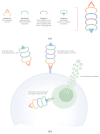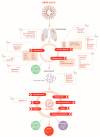Postulated Adjuvant Therapeutic Strategies for COVID-19
- PMID: 32764275
- PMCID: PMC7565841
- DOI: 10.3390/jpm10030080
Postulated Adjuvant Therapeutic Strategies for COVID-19
Abstract
The number of COVID-19 patients is still growing exponentially worldwide due to the high transmissibility of the SARS-CoV-2 virus. Therapeutic agents currently under investigation are antiviral drugs, vaccines, and other adjuvants that could relieve symptoms or improve the healing process. In this review, twelve therapeutic agents that could play a role in prophylaxis or improvement of the COVID-19-associated symptoms (as add-on substances) are discussed. Agents were identified based on their known pharmacologic mechanism of action in viral and/or nonviral fields and are postulated to interact with one or more of the seven known mechanisms associated with the SARS-CoV-2 virus: (i) regulation of the immune system; (ii) virus entrance in the cell; (iii) virus replication; (iv) hyperinflammation; (v) oxidative stress; (vi) thrombosis; and (vii) endotheliitis. Selected agents were immune transfer factor (oligo- and polypeptides from porcine spleen, ultrafiltered at <10 kDa; Imuno TF®), anti-inflammatory natural blend (Uncaria tomentosa, Endopleura uchi and Haematoccocus pluvialis; Miodesin®), zinc, selenium, ascorbic acid, cholecalciferol, ferulic acid, spirulina, N-acetylcysteine, glucosamine sulfate potassium hydrochloride, trans-resveratrol, and maltodextrin-stabilized orthosilicic acid (SiliciuMax®). This review gives the scientific background on the hypothesis that these therapeutic agents can act in synergy in the prevention and improvement of COVID-19-associated symptoms.
Keywords: COVID-19; SARS-CoV-2; adjuvant; compounding; coronavirus; dietary supplement; drug; immunological; pharmacology; therapeutics.
Conflict of interest statement
The authors are affiliated with Fagron-Lichtenauerlaan 182, 3062 ME Rotterdam, The Netherlands.
Figures




Similar articles
-
Pathogenesis-directed therapy of 2019 novel coronavirus disease.J Med Virol. 2021 Mar;93(3):1320-1342. doi: 10.1002/jmv.26610. Epub 2020 Nov 10. J Med Virol. 2021. PMID: 33073355 Review.
-
Multi-omics-based identification of SARS-CoV-2 infection biology and candidate drugs against COVID-19.Comput Biol Med. 2020 Nov;126:104051. doi: 10.1016/j.compbiomed.2020.104051. Epub 2020 Oct 10. Comput Biol Med. 2020. PMID: 33131530 Free PMC article.
-
Designing therapeutic strategies to combat severe acute respiratory syndrome coronavirus-2 disease: COVID-19.Drug Dev Res. 2021 Feb;82(1):12-26. doi: 10.1002/ddr.21720. Epub 2020 Jul 30. Drug Dev Res. 2021. PMID: 33216381 Review.
-
Efficacy of hydroxychloroquine for post-exposure prophylaxis to prevent severe acute respiratory syndrome coronavirus 2 (SARS-CoV-2) infection among adults exposed to coronavirus disease (COVID-19): a structured summary of a study protocol for a randomised controlled trial.Trials. 2020 Jun 3;21(1):475. doi: 10.1186/s13063-020-04446-4. Trials. 2020. PMID: 32493478 Free PMC article.
-
Antiviral Activity of Type I, II, and III Interferons Counterbalances ACE2 Inducibility and Restricts SARS-CoV-2.mBio. 2020 Sep 10;11(5):e01928-20. doi: 10.1128/mBio.01928-20. mBio. 2020. PMID: 32913009 Free PMC article.
Cited by
-
COVID-19 and its genomic variants: Molecular pathogenesis and therapeutic interventions.EXCLI J. 2022 Sep 13;21:1196-1221. doi: 10.17179/excli2022-5315. eCollection 2022. EXCLI J. 2022. PMID: 36381644 Free PMC article. Review.
-
Identification of COVID-19 and Dengue Host Factor Interaction Networks Based on Integrative Bioinformatics Analyses.Front Immunol. 2021 Jul 28;12:707287. doi: 10.3389/fimmu.2021.707287. eCollection 2021. Front Immunol. 2021. PMID: 34394108 Free PMC article.
-
Ferulic Acid as a Protective Antioxidant of Human Intestinal Epithelial Cells.Antioxidants (Basel). 2022 Jul 26;11(8):1448. doi: 10.3390/antiox11081448. Antioxidants (Basel). 2022. PMID: 35892649 Free PMC article.
-
The influence of physical activity level on the length of stay in hospital in older men survivors of COVID-19.Sport Sci Health. 2022;18(4):1483-1490. doi: 10.1007/s11332-022-00948-7. Epub 2022 Jun 11. Sport Sci Health. 2022. PMID: 35730029 Free PMC article.
-
Effects of Arthrospira platensis on Human Umbilical Vein Endothelial Cells.Life (Basel). 2024 Oct 1;14(10):1253. doi: 10.3390/life14101253. Life (Basel). 2024. PMID: 39459553 Free PMC article.
References
-
- Alam I., Almajwal A.M., Alam W., Alam I., Ullah N., Abulmeaaty M., Razak S., Khan S., Pawelec G., Paracha P.I. The immune-nutrition interplay in aging—Facts and controversies. Nutr. Heal. Aging. 2019;5:73–95. doi: 10.3233/NHA-170034. - DOI
Publication types
LinkOut - more resources
Full Text Sources
Other Literature Sources
Miscellaneous

